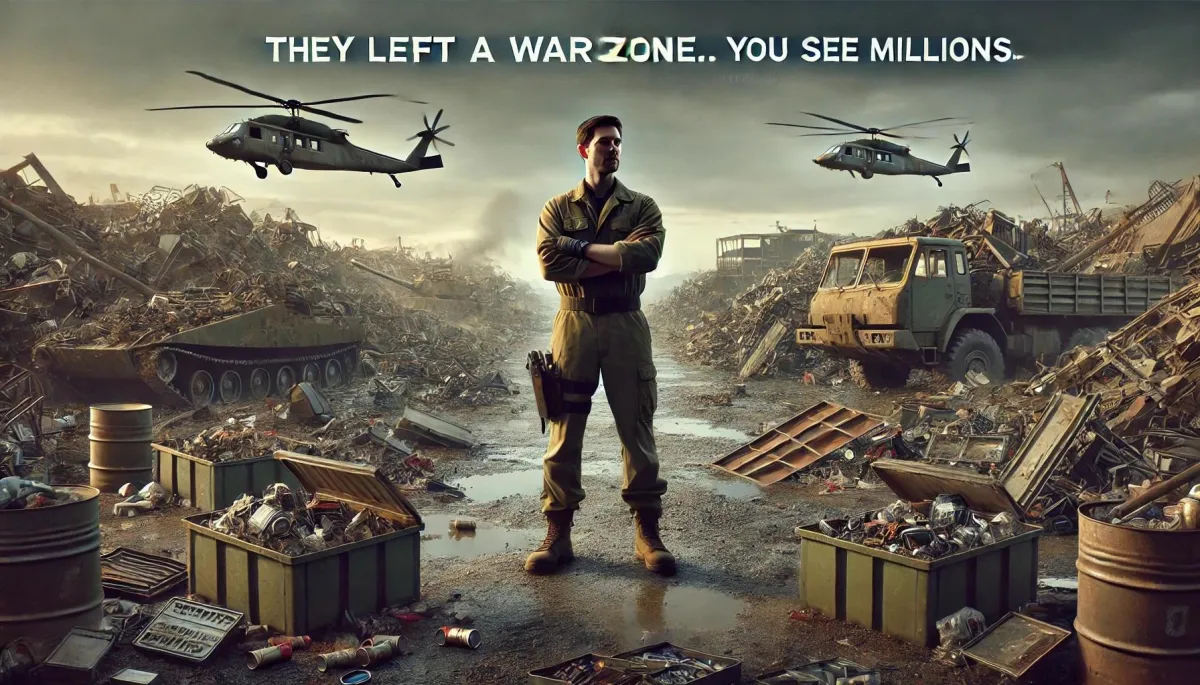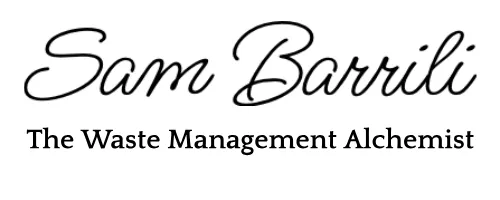Articles

Why 99% of Waste Companies Will Miss the Most Profitable Niche of the Next 10 Years (And How You Can Claim It First)
Let me tell you a story no one in the waste industry dares to tell.
While you're busy chasing contracts for household pickups, recycling bins, and commercial dumpsters, there’s a silent mountain of waste being created on a global scale, and it’s not coming from your average city or suburb.
It's coming from the military.
Not just during wars—but before, during, and long after the last shot is fired.
Most people think of war and see destruction, loss, and chaos.
I look at it and see something else:
Scrap metal. Fuel residue. Burned-out machinery. Damaged electronics. Abandoned outposts. Stockpiles of expired rations, medical supplies, wires, batteries, munitions.
I see raw materials. Inventory. Margin.
And if you’re smart, you should too.
[Book 20 Minutes Free Consultation Call]
The Massive Machine of Waste Production Called “Defense”
Let’s set the stage.
Do you know how much waste the U.S. military alone generates daily in operational theaters?
Between 2 to 5 kilograms per soldier per day.
Multiply that by 10,000 troops.
Now by 30 days.
Now by the number of global deployments, joint bases, and conflict zones active right now.
We’re talking about hundreds of thousands of tons of mixed waste, generated monthly. And that’s just from the personnel side.
Let’s add in the infrastructure side:
Bases built overnight and abandoned in six months.
Mobile units left to rust.
Ammunition bunkers that “expire.”
Communication tech rendered obsolete within a year.
Each of these items contains metal, copper, plastics, rare earth minerals, synthetics, oil-soaked parts, and high-value electronic components that are either left behind, destroyed—or, in most cases—set on fire in giant burn pits.
Yes. Literally burned.
Why?
Because logistics are a nightmare, and most militaries don’t have a system built to extract value from what they consider waste.
Which brings me to my next point…
[Book 20 Minutes Free Consultation Call]
Where Others See Waste, You Should See a Multi-Billion Euro Opportunity
Let’s do a little math.
Say you recover:
5,000 tons of scrap metal from abandoned machinery and vehicles.
1,200 tons of cabling and electronics from military outposts and field equipment.
300 tons of mixed fuel-contaminated containers, drums, and packaging.
At current market rates, those materials—if properly recovered, cleaned, and sold on the secondary market—could yield seven-figure profits.
And that’s just from one medium-scale zone of operation.
Now imagine scaling that to post-conflict areas in:
The Middle East
Central Africa
Eastern Europe
Southeast Asia
I’m not talking about theory here. I’m talking about a model that’s already happened—just not yet optimized or systemized.
The military moves fast. They focus on mission objectives. They’re not in the business of reusing or monetizing what they leave behind.
But we are.
[Book 20 Minutes Free Consultation Call]
The Biggest Challenge Is the Biggest Advantage
Now, I’m going to be honest with you.
Getting into this business is not as easy as bidding on a local landfill management tender.
But that’s exactly why the profits are massive.
Let me explain.
Governments and military alliances (think NATO, the UN, EU defense bodies, private contractors) are desperate for:
Post-conflict cleanup operations
Hazardous material handling
Site decommissioning
Mobile treatment solutions
Why? Because they’re legally required to do it.
It’s in every contract. Every treaty. Every mission charter. Someone needs to clean up the mess—and they pay premium rates for whoever’s crazy (or smart) enough to do it.
And let me be clear: the companies doing this today?
Old-school.
Bureaucratic.
Overpriced.
Under-equipped.
Slow.
The field is wide open for agile, modern, results-driven waste professionals who understand logistics, secondary raw materials, and extraction models that actually work.
If you're already in waste, recycling, or scrap, you're 70% of the way there.
What you're missing is the strategy, positioning, and access.
That's where I come in.
[Book 20 Minutes Free Consultation Call]
Case in Point: The Middle East and the “Ghost Yards” of War
Let me give you a real example that should make your jaw drop.
Across Iraq and Afghanistan, after over 20 years of conflict, there are entire zones filled with destroyed, abandoned, and forgotten U.S. and NATO equipment.
We’re talking:
Armored vehicles
Helicopter frames
Communication towers
Warehouses of unused goods
Most of them are now being auctioned, burned, or left to rot.
Yet a single truckload of scrapped military-grade aluminum and steel from this kind of inventory could net $10,000 to $50,000, depending on what’s inside.
Multiply that by hundreds of loads, and you start to understand the real numbers involved.
[Book 20 Minutes Free Consultation Call]
So Why Hasn’t Everyone Jumped In?
Simple.
Because this is not a game for amateurs.
You need:
Specialized permits
On-ground partners
The ability to navigate defense, politics, and procurement
And a mindset that sees “waste” as a disguised form of cash flow
Most companies are too scared to go after it.
The few who try don’t know how to structure it.
But for the few professionals who get the right guidance, build the right relationships, and position themselves correctly, this is a massive moat business.
No competition.
High ticket.
Long-term contracts.
And once you're in… you're in.
[Book 20 Minutes Free Consultation Call]
What Should You Do With This Information?
If you’ve read this far, then this message is for you.
You already know there’s no future in competing for the same over-saturated municipal contracts. You’ve seen how recycling margins are getting squeezed. You know regulations are tightening, labor costs are rising, and the market is crowded with players who don’t know how to innovate.
Meanwhile, there’s a global engine of high-value waste sitting in deserts, bunkers, and bases, waiting for someone like you to turn it into a systemized business model.
So ask yourself:
Do you want to be another “green business” chasing subsidies and grants, or do you want to own a high-margin, asset-backed, real-world waste recovery business with international clients?
Do you want to stay local, or do you want to play in the big leagues—where a single project can fund your operations for two years?
Do you want to talk about impact, or do you want to create value by transforming overlooked chaos into pure profit?
[Book 20 Minutes Free Consultation Call]
Let’s Cut to the Chase
This is not for everyone.
But if you’ve got guts, and you’re willing to go deep into this niche, I can help you build a model that works.
I’ve helped small and mid-size waste companies across Europe and the U.S. reposition themselves, get the right doors open, and build a game plan around the real profit centers of the waste industry—the stuff no one else wants to touch.
If you're interested in tapping into this opportunity, book a call with me.
I'll show you how to structure your service offering, position your brand, and identify post-conflict or military contract opportunities based on your current capabilities.
[Book 20 Minutes Free Consultation Call]
Because if you wait too long, someone else is going to claim this space.
And trust me…
Once you see what’s buried under the rubble of war, you’ll never look at “waste” the same way again.
Talk soon.
—
Sam Barrili
The Waste Management Alchemist


Sam Barrili
I'm known as the go-to guy for talking about business strategies and growth strategies for waste management companies.
I started my journey in this field in 2009 when I finished my degree in Toxicological Chemistry and joined a wastewater treatment company to develop its market.
Since then, I helped dozens of waste management companies in America and Europe increase their annual profits by over 25 million dollars thanks to my SAM Method.
If you want to know if I'm a good fit for you, read an article or watch a video.
If you find it helpful, I’m probably a good match.
If not, that's OK too.
Call +1 (801) 804-5730
Email: [email protected]

